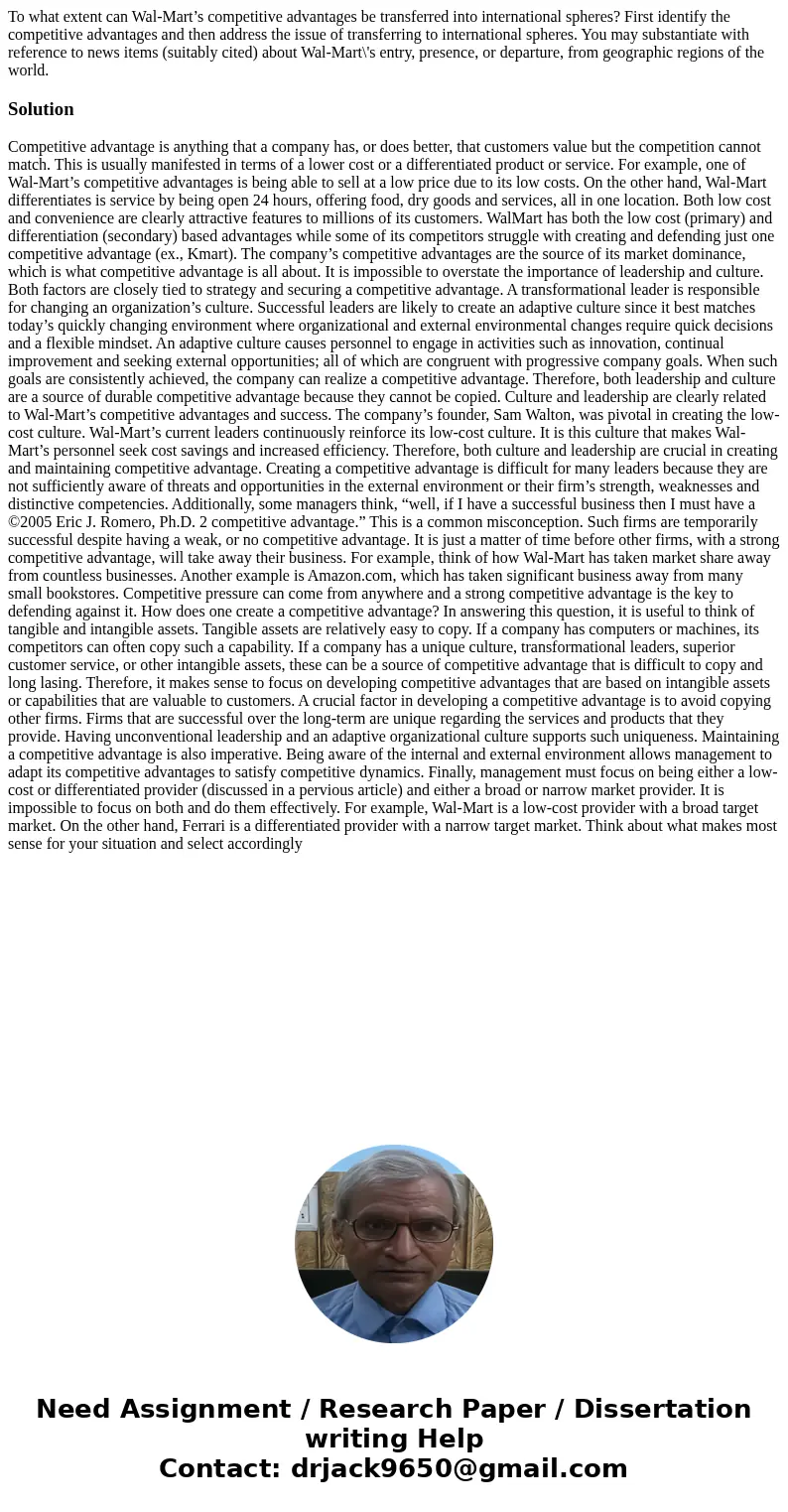To what extent can WalMarts competitive advantages be transf
To what extent can Wal-Mart’s competitive advantages be transferred into international spheres? First identify the competitive advantages and then address the issue of transferring to international spheres. You may substantiate with reference to news items (suitably cited) about Wal-Mart\'s entry, presence, or departure, from geographic regions of the world.
Solution
Competitive advantage is anything that a company has, or does better, that customers value but the competition cannot match. This is usually manifested in terms of a lower cost or a differentiated product or service. For example, one of Wal-Mart’s competitive advantages is being able to sell at a low price due to its low costs. On the other hand, Wal-Mart differentiates is service by being open 24 hours, offering food, dry goods and services, all in one location. Both low cost and convenience are clearly attractive features to millions of its customers. WalMart has both the low cost (primary) and differentiation (secondary) based advantages while some of its competitors struggle with creating and defending just one competitive advantage (ex., Kmart). The company’s competitive advantages are the source of its market dominance, which is what competitive advantage is all about. It is impossible to overstate the importance of leadership and culture. Both factors are closely tied to strategy and securing a competitive advantage. A transformational leader is responsible for changing an organization’s culture. Successful leaders are likely to create an adaptive culture since it best matches today’s quickly changing environment where organizational and external environmental changes require quick decisions and a flexible mindset. An adaptive culture causes personnel to engage in activities such as innovation, continual improvement and seeking external opportunities; all of which are congruent with progressive company goals. When such goals are consistently achieved, the company can realize a competitive advantage. Therefore, both leadership and culture are a source of durable competitive advantage because they cannot be copied. Culture and leadership are clearly related to Wal-Mart’s competitive advantages and success. The company’s founder, Sam Walton, was pivotal in creating the low-cost culture. Wal-Mart’s current leaders continuously reinforce its low-cost culture. It is this culture that makes Wal-Mart’s personnel seek cost savings and increased efficiency. Therefore, both culture and leadership are crucial in creating and maintaining competitive advantage. Creating a competitive advantage is difficult for many leaders because they are not sufficiently aware of threats and opportunities in the external environment or their firm’s strength, weaknesses and distinctive competencies. Additionally, some managers think, “well, if I have a successful business then I must have a ©2005 Eric J. Romero, Ph.D. 2 competitive advantage.” This is a common misconception. Such firms are temporarily successful despite having a weak, or no competitive advantage. It is just a matter of time before other firms, with a strong competitive advantage, will take away their business. For example, think of how Wal-Mart has taken market share away from countless businesses. Another example is Amazon.com, which has taken significant business away from many small bookstores. Competitive pressure can come from anywhere and a strong competitive advantage is the key to defending against it. How does one create a competitive advantage? In answering this question, it is useful to think of tangible and intangible assets. Tangible assets are relatively easy to copy. If a company has computers or machines, its competitors can often copy such a capability. If a company has a unique culture, transformational leaders, superior customer service, or other intangible assets, these can be a source of competitive advantage that is difficult to copy and long lasing. Therefore, it makes sense to focus on developing competitive advantages that are based on intangible assets or capabilities that are valuable to customers. A crucial factor in developing a competitive advantage is to avoid copying other firms. Firms that are successful over the long-term are unique regarding the services and products that they provide. Having unconventional leadership and an adaptive organizational culture supports such uniqueness. Maintaining a competitive advantage is also imperative. Being aware of the internal and external environment allows management to adapt its competitive advantages to satisfy competitive dynamics. Finally, management must focus on being either a low-cost or differentiated provider (discussed in a pervious article) and either a broad or narrow market provider. It is impossible to focus on both and do them effectively. For example, Wal-Mart is a low-cost provider with a broad target market. On the other hand, Ferrari is a differentiated provider with a narrow target market. Think about what makes most sense for your situation and select accordingly

 Homework Sourse
Homework Sourse